Deck 6: Viruses
Question
Question
Question
Question
Question
Question
Question
Question
Question
Question
Question
Question
Question
Question
Question
Question
Question
Question
Question
Question
Question
Question
Question
Question
Question
Question
Question
Question
Question
Question
Question
Question
Question
Question
Question
Question
Question
Question
Question
Question
Question
Question
Question
Question
Question
Question
Question
Question
Question
Question
Question
Question
Question
Question
Question
Question
Question
Question
Question
Question
Question
Question
Question
Question
Question
Question
Question
Question
Question
Question

Unlock Deck
Sign up to unlock the cards in this deck!
Unlock Deck
Unlock Deck
1/70
Play
Full screen (f)
Deck 6: Viruses
1
Which filamentous virus causes a fatal disease in humans and is also related to primates?
A) HIV
B) Ebola
C) smallpox
D) cowpox
E) herpes virus
A) HIV
B) Ebola
C) smallpox
D) cowpox
E) herpes virus
B
2
Which infectious agent is identified by the nucleic acid genome being the entire infectious particle?
A) viruses
B) prions
C) viroids
D) virions
E) bacteria
A) viruses
B) prions
C) viroids
D) virions
E) bacteria
C
3
An icosahedral capsid is classified as having how many sides?
A) 4
B) 6
C) 8
D) 10
E) 20
A) 4
B) 6
C) 8
D) 10
E) 20
E
4
What type of diseases are unique in that they can be transmitted by an infective protein that propagates conformational change of existing molecules without synthesizing entirely new infective molecules?
A) viral
B) viroid
C) bacterial
D) virion
E) prion
A) viral
B) viroid
C) bacterial
D) virion
E) prion

Unlock Deck
Unlock for access to all 70 flashcards in this deck.
Unlock Deck
k this deck
5
Which structure of a virion protects it from degradation and enables it to be transmitted outside the host?
A) capsule
B) capsid
C) envelope
D) nucleus
E) spikes
A) capsule
B) capsid
C) envelope
D) nucleus
E) spikes

Unlock Deck
Unlock for access to all 70 flashcards in this deck.
Unlock Deck
k this deck
6
What role do acute viruses play in their ecosystem?
A) transfer genes across species
B) act as predator or parasite
C) evolve symbiotically with host
D) act as a bioweapon
E) act as a viral shunt
A) transfer genes across species
B) act as predator or parasite
C) evolve symbiotically with host
D) act as a bioweapon
E) act as a viral shunt

Unlock Deck
Unlock for access to all 70 flashcards in this deck.
Unlock Deck
k this deck
7
Which of the following is NOT one of the three forms a virus can assume?
A) prion
B) viral genome integrated within host DNA
C) intracellular replication complex
D) virion
E) virus particle
A) prion
B) viral genome integrated within host DNA
C) intracellular replication complex
D) virion
E) virus particle

Unlock Deck
Unlock for access to all 70 flashcards in this deck.
Unlock Deck
k this deck
8
In bacteriophage T4, the DNA genome is contained in the head, and binding to the host is facilitated by attachment of the
A) capsid.
B) neck.
C) tail fibers.
D) envelope.
E) tegument.
A) capsid.
B) neck.
C) tail fibers.
D) envelope.
E) tegument.

Unlock Deck
Unlock for access to all 70 flashcards in this deck.
Unlock Deck
k this deck
9
Large asymmetrical viruses are distinguished in that they
A) have no envelope.
B) are protein fragments.
C) have few enzymes.
D) have nucleic acids.
E) have many enzymes.
A) have no envelope.
B) are protein fragments.
C) have few enzymes.
D) have nucleic acids.
E) have many enzymes.

Unlock Deck
Unlock for access to all 70 flashcards in this deck.
Unlock Deck
k this deck
10
What can be counted as representing individual infectious virions from a phage suspension?
A) plaques
B) viruses
C) genomes
D) proteomes
E) burst size
A) plaques
B) viruses
C) genomes
D) proteomes
E) burst size

Unlock Deck
Unlock for access to all 70 flashcards in this deck.
Unlock Deck
k this deck
11
A polyhedron with 20 sides has identical ________ faces.
A) helical
B) filamentous
C) rectangular
D) triangular
E) asymmetrical
A) helical
B) filamentous
C) rectangular
D) triangular
E) asymmetrical

Unlock Deck
Unlock for access to all 70 flashcards in this deck.
Unlock Deck
k this deck
12
Some viral species may derive their ________ from intracellular membranes, such as the nuclear membrane or endoplasmic reticulum.
A) capsid
B) genome
C) envelope
D) neck
E) tail fibers
A) capsid
B) genome
C) envelope
D) neck
E) tail fibers

Unlock Deck
Unlock for access to all 70 flashcards in this deck.
Unlock Deck
k this deck
13
All of the following criteria are used to classify viruses according to the International Committee on Taxonomy of Viruses EXCEPT
A) genome composition.
B) size of the virus particle.
C) envelope.
D) capsid symmetry.
E) mutation rate.
A) genome composition.
B) size of the virus particle.
C) envelope.
D) capsid symmetry.
E) mutation rate.

Unlock Deck
Unlock for access to all 70 flashcards in this deck.
Unlock Deck
k this deck
14
Which of the following is a term for the observable destruction of cells as a result of viral lysis?
A) tissue culture
B) lawn
C) soft agar
D) plaque
E) host
A) tissue culture
B) lawn
C) soft agar
D) plaque
E) host

Unlock Deck
Unlock for access to all 70 flashcards in this deck.
Unlock Deck
k this deck
15
Which of the following is INCORRECT about a virus?
A) It may cause human pneumonia.
B) It may be as large as some bacteria.
C) It conducts DNA repair.
D) It conducts protein folding by chaperones.
E) It is a cellular particle.
A) It may cause human pneumonia.
B) It may be as large as some bacteria.
C) It conducts DNA repair.
D) It conducts protein folding by chaperones.
E) It is a cellular particle.

Unlock Deck
Unlock for access to all 70 flashcards in this deck.
Unlock Deck
k this deck
16
Filamentous viruses are classified in part by the pattern of capsid monomers, which form a ________ tube around the genome.
A) icosahedral
B) filamentous
C) asymmetrical
D) complex
E) helical
A) icosahedral
B) filamentous
C) asymmetrical
D) complex
E) helical

Unlock Deck
Unlock for access to all 70 flashcards in this deck.
Unlock Deck
k this deck
17
All of the following are true about the measles virus EXCEPT that it
A) is encased by an envelope of membrane.
B) fuses with the host cell membrane during infection.
C) has progeny that bud out of the host cell.
D) generates a rash of red spots on the skin of infected patients.
E) is never fatal.
A) is encased by an envelope of membrane.
B) fuses with the host cell membrane during infection.
C) has progeny that bud out of the host cell.
D) generates a rash of red spots on the skin of infected patients.
E) is never fatal.

Unlock Deck
Unlock for access to all 70 flashcards in this deck.
Unlock Deck
k this deck
18
The RNA genome of the potato spindle tuber viroid requires which type of modified host polymerase for replication?
A) DNA-dependent DNA polymerase
B) DNA-dependent RNA polymerase
C) RNA-dependent DNA polymerase
D) RNA-dependent RNA polymerase
E) reverse transcriptase
A) DNA-dependent DNA polymerase
B) DNA-dependent RNA polymerase
C) RNA-dependent DNA polymerase
D) RNA-dependent RNA polymerase
E) reverse transcriptase

Unlock Deck
Unlock for access to all 70 flashcards in this deck.
Unlock Deck
k this deck
19
If something descended from a common ancestor, it is
A) monomeric.
B) monophyletic.
C) monogrammed.
D) monosyllabic.
E) monolithic.
A) monomeric.
B) monophyletic.
C) monogrammed.
D) monosyllabic.
E) monolithic.

Unlock Deck
Unlock for access to all 70 flashcards in this deck.
Unlock Deck
k this deck
20
What phages have been used to nucleate the growth of crystalline "nanowires" for electronic devices?
A) icosahedral
B) complex
C) asymmetrical
D) filamentous
E) viroid
A) icosahedral
B) complex
C) asymmetrical
D) filamentous
E) viroid

Unlock Deck
Unlock for access to all 70 flashcards in this deck.
Unlock Deck
k this deck
21
David Baltimore proposed that the primary distinction among classes of viruses was the ________ composition and the route used to express messenger RNA.
A) genome
B) envelope
C) capsid
D) tegument
E) neck
A) genome
B) envelope
C) capsid
D) tegument
E) neck

Unlock Deck
Unlock for access to all 70 flashcards in this deck.
Unlock Deck
k this deck
22
The genome of ________ ssRNA viruses can serve directly as mRNA.
A) positive-sense (+)
B) negative-sense (-)
C) all
D) double-stranded
E) prion
A) positive-sense (+)
B) negative-sense (-)
C) all
D) double-stranded
E) prion

Unlock Deck
Unlock for access to all 70 flashcards in this deck.
Unlock Deck
k this deck
23
A(n) ________ phage may integrate its genome into that of the host cell.
A) lytic
B) temperate
C) viroid
D) asymmetrical
E) oncogenic
A) lytic
B) temperate
C) viroid
D) asymmetrical
E) oncogenic

Unlock Deck
Unlock for access to all 70 flashcards in this deck.
Unlock Deck
k this deck
24
Which of the following steps is NOT part of the life cycle of a lytic phage?
A) Phage DNA is injected into the bacterial cell.
B) The phage DNA integrates into the bacterial chromosome.
C) Many copies of phage DNA are made.
D) The phage DNA is transcribed, and the resulting mRNA is translated to make capsid proteins.
E) All of the steps listed are part of the life cycle of a lytic phage.
A) Phage DNA is injected into the bacterial cell.
B) The phage DNA integrates into the bacterial chromosome.
C) Many copies of phage DNA are made.
D) The phage DNA is transcribed, and the resulting mRNA is translated to make capsid proteins.
E) All of the steps listed are part of the life cycle of a lytic phage.

Unlock Deck
Unlock for access to all 70 flashcards in this deck.
Unlock Deck
k this deck
25
Proteomic analysis predicts seven major evolutionary categories of phage species with subgroups based on
A) type of genetic material.
B) virion structure.
C) shared hosts.
D) transcriptional strategy.
E) replicase gene sequence.
A) type of genetic material.
B) virion structure.
C) shared hosts.
D) transcriptional strategy.
E) replicase gene sequence.

Unlock Deck
Unlock for access to all 70 flashcards in this deck.
Unlock Deck
k this deck
26
Which of the following are genes of common ancestry in two genomes that share the same function?
A) homologs
B) open reading frames
C) proteomes
D) orthologs
E) lysogenic
A) homologs
B) open reading frames
C) proteomes
D) orthologs
E) lysogenic

Unlock Deck
Unlock for access to all 70 flashcards in this deck.
Unlock Deck
k this deck
27
Which of the following is an example of double-stranded RNA viruses?
A) herpes viruses
B) corona viruses
C) retrovirus
D) orthomixoviruses
E) hepadnaviruses
A) herpes viruses
B) corona viruses
C) retrovirus
D) orthomixoviruses
E) hepadnaviruses

Unlock Deck
Unlock for access to all 70 flashcards in this deck.
Unlock Deck
k this deck
28
A key factor in the evolution of killer strains of influenza is that they
A) only have eight genes.
B) have an RNA genome.
C) contain reverse transcriptase.
D) have a segmented genome.
E) have a circular chromosome.
A) only have eight genes.
B) have an RNA genome.
C) contain reverse transcriptase.
D) have a segmented genome.
E) have a circular chromosome.

Unlock Deck
Unlock for access to all 70 flashcards in this deck.
Unlock Deck
k this deck
29
Viruses may be classified by the ________ method.
A) Annapolis
B) Baltimore
C) Orono
D) Augusta
E) Portland
A) Annapolis
B) Baltimore
C) Orono
D) Augusta
E) Portland

Unlock Deck
Unlock for access to all 70 flashcards in this deck.
Unlock Deck
k this deck
30
What viruses are classified by using the suffix viridae?
A) genera
B) families
C) species
D) orders
E) classes
A) genera
B) families
C) species
D) orders
E) classes

Unlock Deck
Unlock for access to all 70 flashcards in this deck.
Unlock Deck
k this deck
31
CRISPR is a(n)
A) bacterial gene.
B) bacterial enzyme.
C) bacterial immune system.
D) inactive viral RNA.
E) cascade protein.
A) bacterial gene.
B) bacterial enzyme.
C) bacterial immune system.
D) inactive viral RNA.
E) cascade protein.

Unlock Deck
Unlock for access to all 70 flashcards in this deck.
Unlock Deck
k this deck
32
The number of virus particles released at lysis is referred to as
A) the lytic number.
B) burst size.
C) the lysogenic number.
D) the temperate number.
E) the release number.
A) the lytic number.
B) burst size.
C) the lysogenic number.
D) the temperate number.
E) the release number.

Unlock Deck
Unlock for access to all 70 flashcards in this deck.
Unlock Deck
k this deck
33
So far, the known mechanisms of replication and mRNA expression define how many fundamental groups of virus species?
A) five
B) six
C) seven
D) eight
E) nine
A) five
B) six
C) seven
D) eight
E) nine

Unlock Deck
Unlock for access to all 70 flashcards in this deck.
Unlock Deck
k this deck
34
When a bacterial cell is infected, the virus protection coat
A) enters the host cell with the viral genome.
B) remains on the outside of the host cell.
C) enters the host cell separately from the viral genome.
D) is released to attach to and inject another host cell.
E) becomes part of the host cell membrane.
A) enters the host cell with the viral genome.
B) remains on the outside of the host cell.
C) enters the host cell separately from the viral genome.
D) is released to attach to and inject another host cell.
E) becomes part of the host cell membrane.

Unlock Deck
Unlock for access to all 70 flashcards in this deck.
Unlock Deck
k this deck
35
The integrated phage genome is called a(n)
A) temperate.
B) lysogen.
C) oncogene.
D) lytic.
E) prophage.
A) temperate.
B) lysogen.
C) oncogene.
D) lytic.
E) prophage.

Unlock Deck
Unlock for access to all 70 flashcards in this deck.
Unlock Deck
k this deck
36
Dysbiosis is the result of
A) deterioration of health due to loss of bacteria.
B) increase in health due to loss of bacteria.
C) host bacterium undergoing a lytic cycle.
D) host bacterium undergoing a lysogenic cycle.
E) slow release.
A) deterioration of health due to loss of bacteria.
B) increase in health due to loss of bacteria.
C) host bacterium undergoing a lytic cycle.
D) host bacterium undergoing a lysogenic cycle.
E) slow release.

Unlock Deck
Unlock for access to all 70 flashcards in this deck.
Unlock Deck
k this deck
37
Which of the following is NOT true of the pararetroviruses?
A) They have an RNA genome.
B) They do not make a DNA intermediate.
C) Some have a viral reverse transcriptase.
D) Some use a host reverse transcriptase.
E) They consist of human and plant pathogens.
A) They have an RNA genome.
B) They do not make a DNA intermediate.
C) Some have a viral reverse transcriptase.
D) Some use a host reverse transcriptase.
E) They consist of human and plant pathogens.

Unlock Deck
Unlock for access to all 70 flashcards in this deck.
Unlock Deck
k this deck
38
Hershey & Chase (1952) showed that the transmission of DNA by a bacteriophage to a host cell led to the production of progeny bacteriophages. What did this confirm?
A) DNA is the hereditary material.
B) Viruses can infect bacteria.
C) Phage genomes can integrate into a bacterial genome.
D) Phages inject their genome through the cell envelope.
E) Various host molecules can serve as a phage receptor.
A) DNA is the hereditary material.
B) Viruses can infect bacteria.
C) Phage genomes can integrate into a bacterial genome.
D) Phages inject their genome through the cell envelope.
E) Various host molecules can serve as a phage receptor.

Unlock Deck
Unlock for access to all 70 flashcards in this deck.
Unlock Deck
k this deck
39
The proteomic tree of bacteriophages is based on comprehensive analysis of viral
A) DNAs.
B) RNAs.
C) proteins.
D) capsids.
E) host ranges.
A) DNAs.
B) RNAs.
C) proteins.
D) capsids.
E) host ranges.

Unlock Deck
Unlock for access to all 70 flashcards in this deck.
Unlock Deck
k this deck
40
Which structure remains outside, attached to the cell surface, after the genome is inserted?
A) an envelope
B) a neck
C) tail fibers
D) a ghost
E) temperate
A) an envelope
B) a neck
C) tail fibers
D) a ghost
E) temperate

Unlock Deck
Unlock for access to all 70 flashcards in this deck.
Unlock Deck
k this deck
41
Some viruses require an RNA-dependent RNA polymerase. What does that mean? What would you call the host cell RNA polymerase (RNA pol)? What would you call reverse transcriptase (RTase)?

Unlock Deck
Unlock for access to all 70 flashcards in this deck.
Unlock Deck
k this deck
42
Name the different types of receptors shown in the figure below.
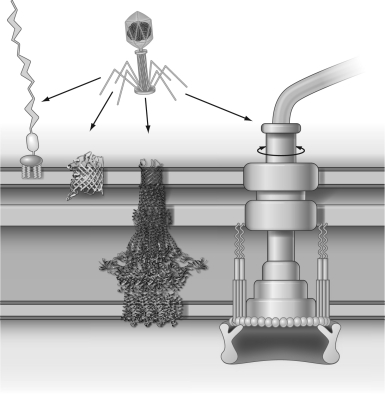


Unlock Deck
Unlock for access to all 70 flashcards in this deck.
Unlock Deck
k this deck
43
What happens when marine algae overgrows?

Unlock Deck
Unlock for access to all 70 flashcards in this deck.
Unlock Deck
k this deck
44
Discuss the role that marine viruses play in carbon balance.

Unlock Deck
Unlock for access to all 70 flashcards in this deck.
Unlock Deck
k this deck
45
Which virus is differentiated by being taken up by endocytosis?
A) hepatitis C
B) human immunodeficiency virus (HIV)
C) gonorrhea
D) syphilis
E) chlamydia
A) hepatitis C
B) human immunodeficiency virus (HIV)
C) gonorrhea
D) syphilis
E) chlamydia

Unlock Deck
Unlock for access to all 70 flashcards in this deck.
Unlock Deck
k this deck
46
What is NOT a difficulty of culturing viruses?
A) tropism for particular tissue
B) tissue culture may not show organ property
C) loss of virulence
D) able to observe a large population
E) need a double culture of host cell and viruses
A) tropism for particular tissue
B) tissue culture may not show organ property
C) loss of virulence
D) able to observe a large population
E) need a double culture of host cell and viruses

Unlock Deck
Unlock for access to all 70 flashcards in this deck.
Unlock Deck
k this deck
47
Tissue cultures are more feasible than whole animals for viral growth because they
A) can develop vaccines.
B) can test a multitude of chemical and antibiotic agents.
C) are more time-consuming.
D) are less expensive.
E) are more expensive.
A) can develop vaccines.
B) can test a multitude of chemical and antibiotic agents.
C) are more time-consuming.
D) are less expensive.
E) are more expensive.

Unlock Deck
Unlock for access to all 70 flashcards in this deck.
Unlock Deck
k this deck
48
Within a host, receptor molecules can also determine the ________, or tendency to infect a particular tissue type.
A) tropism
B) host range
C) virulence
D) burst size
E) plaque
A) tropism
B) host range
C) virulence
D) burst size
E) plaque

Unlock Deck
Unlock for access to all 70 flashcards in this deck.
Unlock Deck
k this deck
49
In contrast to animal viruses and bacteriophages, plant viruses infect cells by mechanisms that do NOT involve specific
A) receptors.
B) membranes.
C) envelopes.
D) vectors.
E) hosts.
A) receptors.
B) membranes.
C) envelopes.
D) vectors.
E) hosts.

Unlock Deck
Unlock for access to all 70 flashcards in this deck.
Unlock Deck
k this deck
50
What is the advantage of symmetry in viral particles?

Unlock Deck
Unlock for access to all 70 flashcards in this deck.
Unlock Deck
k this deck
51
The proteins found in animals and plants that can recognize general signs of viral infections are
A) RNA interference.
B) interferons.
C) T-lymphocytes.
D) surface receptors.
E) antibodies.
A) RNA interference.
B) interferons.
C) T-lymphocytes.
D) surface receptors.
E) antibodies.

Unlock Deck
Unlock for access to all 70 flashcards in this deck.
Unlock Deck
k this deck
52
Which is the period of time that is categorized by virtually undetectable virions inside the infected cell?
A) eclipse
B) latent
C) rise
D) burst
E) lag
A) eclipse
B) latent
C) rise
D) burst
E) lag

Unlock Deck
Unlock for access to all 70 flashcards in this deck.
Unlock Deck
k this deck
53
Who was distinguished for modifying tissue culture procedure for plaque assays?
A) David Baltimore
B) Renato Dulbecco
C) Xinzheng Zhang
D) Paulo Verardi
E) Howard Temin
A) David Baltimore
B) Renato Dulbecco
C) Xinzheng Zhang
D) Paulo Verardi
E) Howard Temin

Unlock Deck
Unlock for access to all 70 flashcards in this deck.
Unlock Deck
k this deck
54
Why are viruses not affected by antibiotics? Why are there so few antiviral drugs?

Unlock Deck
Unlock for access to all 70 flashcards in this deck.
Unlock Deck
k this deck
55
Identify the outer structure shown in the figure below. What is it composed of and how does it differ from the bacterial version?
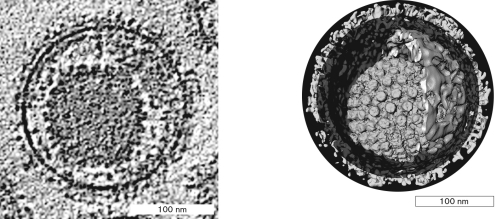


Unlock Deck
Unlock for access to all 70 flashcards in this deck.
Unlock Deck
k this deck
56
What are prions and how do they cause disease?

Unlock Deck
Unlock for access to all 70 flashcards in this deck.
Unlock Deck
k this deck
57
The primary factor determining the life cycle of an animal virus is the physical form of the
A) envelope.
B) capsid.
C) genome.
D) receptor.
E) burst.
A) envelope.
B) capsid.
C) genome.
D) receptor.
E) burst.

Unlock Deck
Unlock for access to all 70 flashcards in this deck.
Unlock Deck
k this deck
58
Why do many RNA viruses encode their own RNA-dependent RNA polymerase and package them in viral particles? How do we take advantage of these viral-specific polymerases?

Unlock Deck
Unlock for access to all 70 flashcards in this deck.
Unlock Deck
k this deck
59
Compare and contrast the Baltimore classification of viruses to the proteomic analysis of bacteriophages. Which more accurately reflects the significant impact of phage evolution?

Unlock Deck
Unlock for access to all 70 flashcards in this deck.
Unlock Deck
k this deck
60
Which of the following is FALSE concerning HIV?
A) It is the causative agent of AIDS.
B) It makes a DNA copy of its RNA genome.
C) Reverse transcriptase is translated from an early gene.
D) The virion contains two copies of the HIV genome.
E) The viral RNA is copied into double-stranded DNA.
A) It is the causative agent of AIDS.
B) It makes a DNA copy of its RNA genome.
C) Reverse transcriptase is translated from an early gene.
D) The virion contains two copies of the HIV genome.
E) The viral RNA is copied into double-stranded DNA.

Unlock Deck
Unlock for access to all 70 flashcards in this deck.
Unlock Deck
k this deck
61
To count the number of viruses in a solution, one can perform a plaque assay. Describe how a plaque is generated in the case of a lytic virus and how a virus that does not lyse its host can be detected.

Unlock Deck
Unlock for access to all 70 flashcards in this deck.
Unlock Deck
k this deck
62
How is the technique displayed in the figure below used to count virions in a solution?
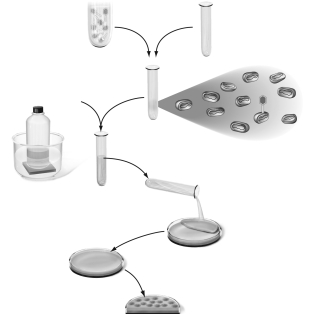


Unlock Deck
Unlock for access to all 70 flashcards in this deck.
Unlock Deck
k this deck
63
How can a virus be used to transfer genes from one bacterial cell to another?

Unlock Deck
Unlock for access to all 70 flashcards in this deck.
Unlock Deck
k this deck
64
Evaluate what determines which cycle a temperate phage will go through as shown in the figure below.
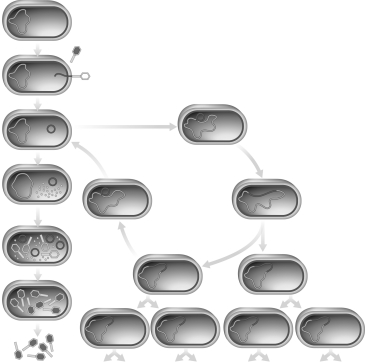


Unlock Deck
Unlock for access to all 70 flashcards in this deck.
Unlock Deck
k this deck
65
Why was the advent of tissue culture heralded as the end of the "monkey era"? What types of things are we able to do with it?

Unlock Deck
Unlock for access to all 70 flashcards in this deck.
Unlock Deck
k this deck
66
During the eclipse period of a viral infection, why are the virions undetectable in the growth medium?

Unlock Deck
Unlock for access to all 70 flashcards in this deck.
Unlock Deck
k this deck
67
What determines the host range and tropism of a virus?

Unlock Deck
Unlock for access to all 70 flashcards in this deck.
Unlock Deck
k this deck
68
Define oncogenes and oncogenic viruses, and explain how they can be used in gene therapy.

Unlock Deck
Unlock for access to all 70 flashcards in this deck.
Unlock Deck
k this deck
69
Explain the process shown in the figure below.
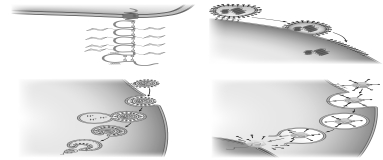


Unlock Deck
Unlock for access to all 70 flashcards in this deck.
Unlock Deck
k this deck
70
What is it necessary for bacteriophage and animal virus entry into a cell? How does that differ from plant viral entry?

Unlock Deck
Unlock for access to all 70 flashcards in this deck.
Unlock Deck
k this deck



